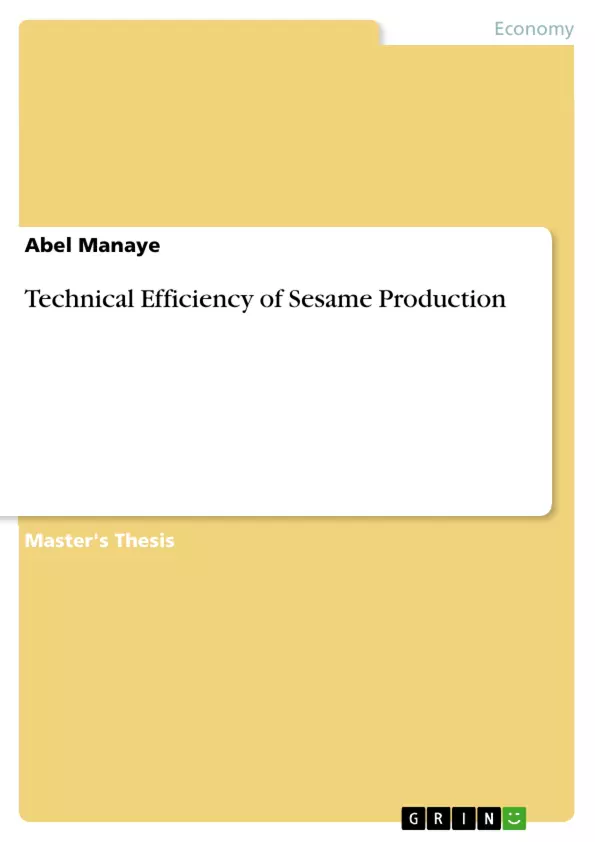This study aimed to analyze the technical efficiency of sesame production in Humera area and to identify major factors that cause efficiency differentials of smallholder farmers. The objective of the study is to measure the technical efficiency of small holder farmers in sesame production.
The study was conducted using a cross sectional data collected in 2015/2016-production year from a total sample of 110 households. Cobb-Douglas function was employed to estimate technical efficiency of smallholder farmers in sesame production. The finding of the study indicated that there is inefficiency in the production of sesame in the study area. The estimation of the frontier model with inefficiency variables shows that the mean technical efficiency of farmers is 0.69 (69%). This implies that production of sesame can be increased by 31 percent given the existing technological level. This indicates that the farmers did not using production inputs efficiently in such a way that they give their maximum potential.
The estimated stochastic production frontier model together with the inefficiency parameters suggests that any attempt to strengthen technical efficiency of smallholder farmers in the study area must give due attention to the improvement of the principal causes for efficiency differentials such as education, age, extension contact, credit availability, off farm activities and proximity, which were found to be significant determinants of efficiency level. The negative coefficient of educational status, age, credit availability, extension contact and off farm activities means these factors are important in determining the existing efficiency of farmers positively and significantly. While the positive coefficients of proximity indicate that the increments in these factors increase inefficiency. Given the limited resources in the study area will enable the concerned parties engaged in efforts for improvement of the product and productivity of this part of the community to bring about the desired changes in a cost effective way than trying to inject an investment on the production of sesame.
Inhaltsverzeichnis (Table of Contents)
- CHAPTER ONE
- 1. INTRODUCTION
- 1.1. Background of the study
- 1.2. Statement of the Problem
- 1.3. Objectives of the Study
- 1.4. Hypothesis of the Study
- 1.5. Significance of the Study
- 1.6. Scope and Limitation of the Study
- 1.7. Organization of the thesis
- CHAPTER TWO
- 2. LITERATURE REVIEW
- 2.1. Theoretical Concept
- 2.1.1. Concepts of Technical Efficiency
- 2.1.2. Measurement Issues of Technical Efficiency
- 2.2. Empirical Evidence
- 2.2.1. World Sesame Production
- 2.2.2. Sesame Production in Ethiopia
- 2.2.3. Major Sesame Seed Producing Zones
- 2.2.4. Empirical Findings Outside Ethiopia
- 2.2.5. Empirical Finding on Ethiopian Farms
- 2.3. Conceptual Framework
- CHAPTER THREE
- 3. RESEARCH METHODOLOGY
- 3.1. Description of the Study Area
- 3.2. Sampling Technique
- 3.3. Sources and Method of Data Collection
- 3.4. Methods of Data Analysis
- 3.4.1 Efficiency Estimation
- 3.5. Variables as measured in the Model
- CHAPTER FOUR
- RESULTS AND DISCUSSION
- 4.1. Descriptive Results
- 4.1.1. Demographic Characteristics
- 4.1.2. Input Basis of the Farmers
- 4.1.3. Production Practices
- 4.1.4. Institutional Support
- 4.1.5. Major Production Constraints
- 4.2. Econometric Analysis Results
- 4.2.1. Maximum Likelihood Estimates of Parameters of the Models
- 4.2.2. Technical Efficiency Scores
- 4.2.3. Actual potential level of sesame output
- 4.2.4. Technical Inefficiency
- CHAPTER FIVE
- 5. CONCLUSIONS AND RECOMMONDATIONS
- 5.1. Conclusions
- 5.2. Recommendation
- 5.3. Suggestions for Future Research
- REFERENCES
- APPENDICES
Zielsetzung und Themenschwerpunkte (Objectives and Key Themes)
This thesis investigates the technical efficiency of sesame production among smallholder farmers in the Kafa Humera area of Ethiopia. The research seeks to identify factors influencing technical efficiency and propose recommendations for enhancing sesame production.
- Technical efficiency of sesame production in the study area
- Factors influencing technical efficiency of sesame production
- Determinants of technical inefficiency in sesame production
- Recommendations for improving technical efficiency and sesame production
- Policy implications for promoting sustainable sesame production
Zusammenfassung der Kapitel (Chapter Summaries)
- Chapter One provides an introduction to the study, outlining the background, statement of the problem, objectives, hypothesis, significance, scope, and limitations of the research.
- Chapter Two presents a comprehensive literature review, exploring theoretical concepts of technical efficiency and its measurement, as well as empirical evidence on sesame production in Ethiopia and globally.
- Chapter Three details the research methodology employed, including the study area, sampling technique, data collection methods, and data analysis techniques.
- Chapter Four presents and discusses the results of the analysis, focusing on descriptive statistics of farmer characteristics and production practices, as well as econometric estimates of technical efficiency scores and determinants of inefficiency.
Schlüsselwörter (Keywords)
This research focuses on technical efficiency, sesame production, smallholder farmers, Ethiopia, Kafa Humera, production constraints, and policy implications.
- Quote paper
- Abel Manaye (Author), 2016, Technical Efficiency of Sesame Production, Munich, GRIN Verlag, https://www.grin.com/document/368174



